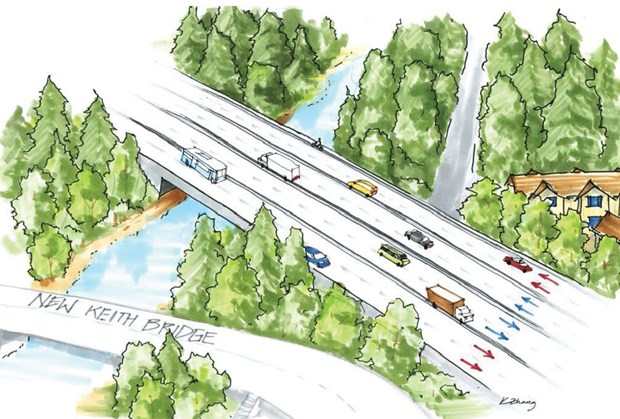Transportation planners from the District of North Vancouver and province are floating a new idea aimed at easing traffic on the Cut.
District council members got their first look Monday night at a new design for a “collector distribution system” – a concrete barrier dividing traffic bound for the Ironworkers Memorial Second Narrows Crossing from traffic headed for local exits.
“The weaving and merging that happens on the highway would then happen on a separated road system,” said Tegan Smith, transportation planner for the district. “Staff believe this option provides significant capacity to separate the local and the highway traffic and starts to get at the heart of the issues that have been facing the district’s transportation network.”
Similar dividers are used on highways running around Surrey, Montreal and Toronto. For drivers coming down the cut, the “decision point” would be just before the Mountain Highway overpass. The idea would be contingent on the province and feds coming up with grants to help pay the cost of installing a new eight-lane Highway 1 bridge over Lynn Creek.
The staff presentation did not include a cost estimate for the collector distribution idea, but it would be on top of the $150-million price tag for the already-in-the-works revamp of all three interchanges at the bridgehead. The Ministry of Transportation has hired a consultant to model traffic flows on the Highway 1 corridor, looking to see if the collector distribution system will have a real-life impact on travel times. Those results are due in June.
While much of council was eager to see anything that might ease congestion, there was debate over whether the costs would prove worthwhile, particularly from Coun. Mathew Bond, who is a transportation systems engineer with the ministry.
Big-ticket road widening projects have been shown to have counterproductive results, Bond said. He pointed to Texas spending $2.3 billion widening the Katy Freeway in Houston up to 23 lanes only to have travel times for commuters increase by 51 per cent in the following three years.
“I’m worried we might be doing the popular thing and not necessarily the good thing or the right thing,” he said.
The issue ought to be of particular significance for young people, who tend to have less car-reliant lifestyles, Bond said, but rarely participate in council’s consultation processes.
“I question these (assumptions). I want to see the data. Show me that it’s going to work. Show me that it makes sense for the long term because for the next 20 or 30 years of debt financing it takes to pay for this, we’re going to be paying the bill,” he said.
But the point of the project isn’t just to clear-up notorious Cut traffic for commuters headed over the Ironworkers, others on council argued, but rather to separate our own local east-west traffic.
“Is it going to solve everything? No. Is it going to be expensive? Yup. Do we have to do it? I think we do,” Coun. Lisa Muri said. “Think good thoughts that this will happen before we all retire.”
And with driverless vehicles coming on the market soon and fundamentally changing commuter patterns, the highway projects may prove to have lots of capacity for the future, Coun. Roger Bassam added.
“We don’t know where this is going but we do know the engineering we have right now is not very good. It’s not very efficient,” he said.
Detailed design work for the Mountain Highway interchange, meanwhile, is nearly 90 per cent done and contracts for the work will be tendered over the summer, with construction coming this fall.



